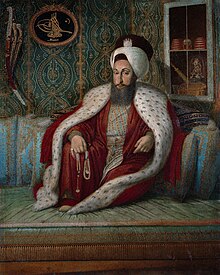First Serbian uprising
The First Serbian Uprising (prvi srpski ustanak) from 1804 to 1813 was the first national and social revolutionary uprising during the Serbian Revolution , as a result of which Serbia was completely emancipated from the Ottoman Empire and subsequently established as a nation state . After 300 years of Ottoman hegemony, the Wars of Independence in the first and subsequent Second Serbian Uprising ( Drugi srpski ustanak ) 1815–1817, the first phase of the Serbian Revolution, led to the second phase (1815–1833), in which diplomatic negotiations with the Sublime Porte took place official recognition of the sovereign Serbian principality followed and thus the Serbian Revolution was finally successfully ended.
In the first phase of the Serbian Revolution, Serbian statehood increased through the establishment of the Serbian principality with the formation of a government ( Praviteljstvujušči sovjet serbski , German: Governing Council of Serbs ), a parliament, the adoption of a constitution, the coronation of a sovereign, and education of a forerunner of today's University of Belgrade take their first concrete contours.
The external trigger for the first Serbian uprising was a massacre of 72 Serbian Knezen (village elders).
background

After the defeat of the Ottoman Empire in the Turkish-Austrian War in 1791 , the Serbs began to see the potential for success in an uprising against the Ottomans. Sultan Selim III. initially gave the Serbs more rights due to the growing resentment among the population, such as B. freedom of trade and religion. In addition, the Janissaries had to leave Belgrade.
However, on January 30, 1799, an Ottoman court allowed the Janissaries to return. They and their leaders, the Agas , and even the Ottoman government, showed little respect for the local authorities. After the killing of the vizier Hacı Mustafa Pasha in 1801, the recently passed laws were suspended and the Ağas exercised full power in Serbia. Taxes were drastically increased, land was confiscated, forced labor ( čitlučenje ) was introduced, and many citizens fled for fear of the Janissaries.
Beginning and course
After the Ağas found out that Serbian leaders were planning a revolt, they arrested the leaders and killed them on February 4, 1804, now known as Seča knezova (Massacre of the Serbian Knezen).
On February 14, 1804, some Serb leaders gathered in the small village of Orašac in Šumadija and decided the uprising. Đorđe Petrović , called "Karađorđe" (Black Đorđe), was elected as the leader of the uprising. The uprising began in the afternoon with the setting on fire of a Turkish inn ( caravanserai ) in Orašac; its residents fled or were killed. Similar measures were taken in the surrounding villages. Soon afterwards the cities of Požarevac and Valjevo were liberated and the siege of Belgrade began .
When he was informed of the uprising, Sultan Selim III began. immediately to negotiate with the rebels without achieving a result. The uprising had now spread across the country. In Constantinople they feared an expansion of the uprising to other occupied territories and sent the Bosnian Pasha Bećiru with 3000 men to Belgrade. This had the order to drive out the Agas. They were captured and killed on the island of Ada Kaleh on the Danube . The pasha appointed 20 Serbs as princes in order to meet the demands of the rebels. Ultimately, however, the negotiations failed and the Sultan began a military operation against the insurrection.
The first major battle of the uprising was the Battle of Ivankovac in 1805, in which Karađorđe defeated the Turkish army and forced them to retreat towards Niš . The second major battle was the 1806 Battle of Mišar , in which the rebels, led by Captain Kulin, defeated the Ottoman army of Bosnia . At the same time, rebels led by Petar Dobrnjac defeated another army of the Ottoman Empire and they marched from the southeast into the battle of Deligrad. Belgrade was besieged by the rebels in December 1806 and liberated in early 1807. From 1805 onwards, the insurgents had received help from Russia, which was at war with the Ottomans.
Result
In 1805 the Serb rebels organized a provisional government during the uprising. The previously seized land has been returned, forced labor abolished and taxes reduced. The country was modernized and in 1808 the Great School was built in Belgrade , which is now known as the University of Belgrade .
Some leaders abused their privileges for personal gain by reintroducing forced labor in some places. There was an argument between Karađorđe and the other leaders. He wanted absolute power, while his voivods wanted to limit it. In 1813 the Ottoman Empire used the turmoil after the Russo-Turkish War (1806-1812) to recapture Serbia.
Although ultimately unsuccessful, the First Serbian Uprising paved the way for the Second Serbian Uprising in 1815, when the Ottomans finally granted Serbia full autonomy.
Butcher
The most famous battles or the most famous siege of the first Serbian uprising were:
Important persons
- Karađorđe
- Tanasko Rajić
- Ilija Birčanin
- Jakov Nenadović
- Mateja Nenadović
- Milenko Stojković
- Hajduk Veljko
- Petar Dobrnjac
- Stanoje Glavaš
- Vuk Stefanović Karadžić
See also
literature
- Holm Sundhaussen : History of Serbia. 19. – 21. Century . Böhlau, Cologne / Weimar, 2007, ISBN 978-3-205-77660-4 .
- Dunja Melčić: The Yugoslavia War. Prehistory, course and consequences manual . Westdeutscher Verlag, Opladen / Wiesbaden, 1999, ISBN 3-531-13219-9 , pp. 98/99.




